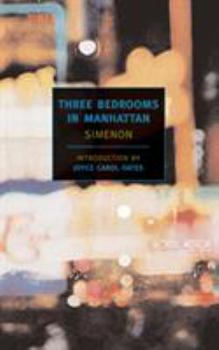Three Bedrooms in Manhattan
Select Format
Select Condition 
Book Overview
Orbis. Madrid. 1997. 21 cm. 196 p. Encuadernación en tapa dura de editorial ilustrada. Simenon, Georges 1903-1989. Traducción, Carlos Manzano. Grandes pasiones de la literatura. Traducción de: Trois... This description may be from another edition of this product.
Format:Paperback
Language:English
ISBN:159017044X
ISBN13:9781590170441
Release Date:October 2003
Publisher:New York Review of Books
Length:176 Pages
Weight:0.35 lbs.
Dimensions:0.4" x 4.8" x 8.2"
Customer Reviews
3 ratings
For some people it's easy
Published by Thriftbooks.com User , 15 years ago
Let me add that Simenon offers that rare combination in art--artistic skill and fabulous productivity. There's Mozart and Hayden and Bellini and Des Prez and Defoe, as against the tormented labors of Beethoven. There's Dickens and Simenon and Shakespeare and A Trollope and Hugo and Dumas (pere), and DeMeung, as against Conrad and Flaubert and Hemingway, who suffered and suffered. Some people are born lucky. Are there any interviews with Simenon that offer an explanation? By the way, Simenon's closest peer in the golden age of detective fiction is Graham Greene: Both are consumate wordsmiths, both eschew the vegetive world tho setting their fictions in romantic locals, and both write successfully in several modes of fiction.
Set Your Dogs And Wolves On Me
Published by Thriftbooks.com User , 19 years ago
Though neither a crime nor a detective novel, Georges Simenon's Three Bedrooms in Manhattan (1946) nonetheless takes place in the lonely, desperate, claustrophobic, and paranoid world of most of the author's other books--of which there are hundreds. The story of a recently divorced French actor, Francios, who takes up solitary residence in Manhattan until he encounters and becomes dependent upon an unattached woman who is also of foreign birth, Three Rooms In Manhattan is a dark examination of a crippled human psyche. Simenon had few peers when it came to writing psychological fiction, and despite a hopeful if slightly improbable ending, the novel is gripping and seductive. Simenon also excelled at recording the vicissitudes of human emotion under stress, and his earnest depiction of Francios, who is crippled by jealousy, delusion, and rage, is superb. Early in the novel, Simenon shrewdly depicts Kay, the object of Francios's obsession, as a listless, calculating mythomaniac, so much so that during the book's first 50 pages, Kay seems like one of the permanently wounded, misplaced female protagonists found in Jean Rhys' five novels. But readers are seeing Kay through Francios's blighted eyes, and Kay eventually manifests on the page in quite a different fashion. Nonetheless, Three Rooms In Manhattan revels in the grim, the sordid, and the violent, and an ugly fog of sadomasochism continually hangs in the air. Few 20th Century writers, with the exception of Denis De Rougemont, Jean Genet, and Vita Sackville-West, in her diaries, have had the courage to depict the cruelty and desire for domination and submission that lies just beneath the surface of passionate love. Appropriately, the book takes place in mid-autumn, when the New York City weather routinely shifts between the transcendent and the unpleasant. The novel's first half revolves around a sometimes nightmarish schedule of endless, compulsive, and directionless walks which the couple takes through the city. Stopping only to drink and smoke in bars, and occasionally to eat, Francios and Kay are two lost souls seeking solace in one another, and both incapable of being apart and unable to be alone, except for the briefest of intervals. All the while, unspoken suspicions, recriminations, and phantoms from the past hang in the air. Modern readers may find Francios misogynist in the extreme, as he spends a great amount of psychic energy spewing volleys of hatred towards Kay in his imagination, even while he walks calmly beside her through the haunted city streets. The idea of taking active revenge against all of the women who have wounded him--especially against his ex-wife, who has left him for a much younger man--through Kay is never far from his consciousness. But Simenon superbly reveals how it is the ostensibly subservient and masochistic Kay, and not Francios, who is the stronger of the two. Accepting even physical abuse, Kay manages to remain perceptive, objective, and resilient, whi
classic
Published by Thriftbooks.com User , 25 years ago
one of the best true to life love stor






